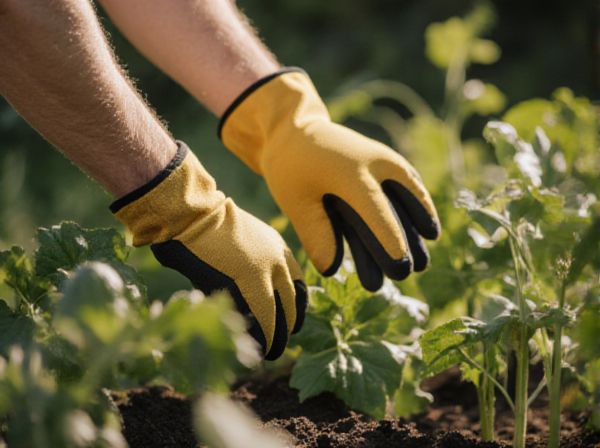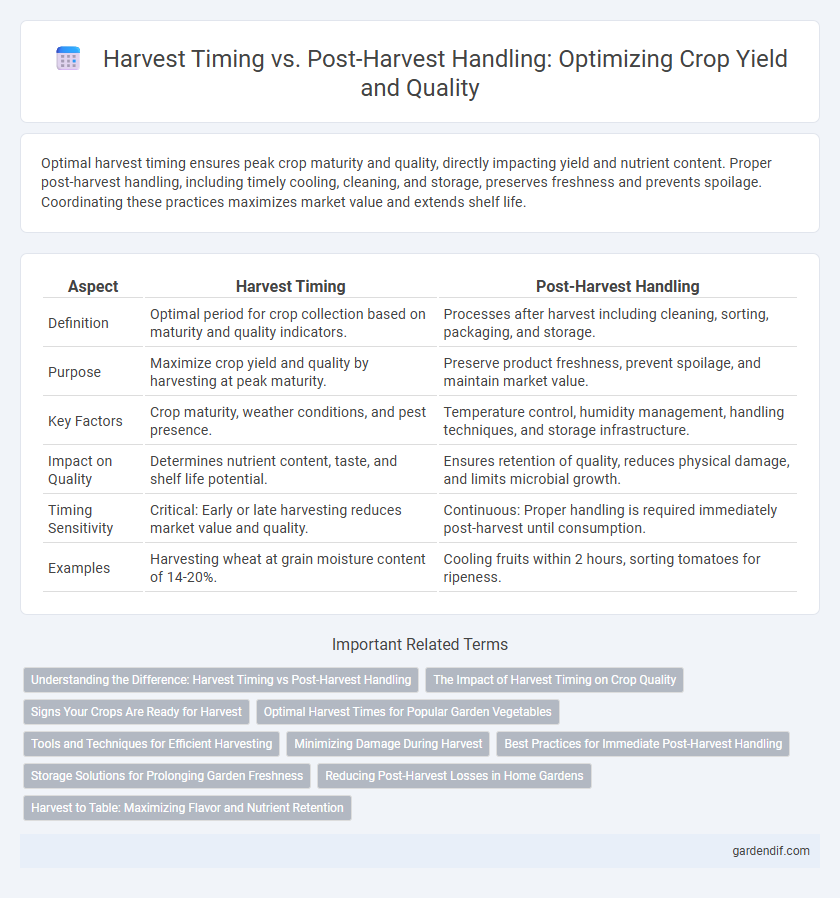
Harvest Timing vs Post-Harvest Handling Illustration
Optimal harvest timing ensures peak crop maturity and quality, directly impacting yield and nutrient content. Proper post-harvest handling, including timely cooling, cleaning, and storage, preserves freshness and prevents spoilage. Coordinating these practices maximizes market value and extends shelf life.
Table of Comparison
| Aspect | Harvest Timing | Post-Harvest Handling |
|---|---|---|
| Definition | Optimal period for crop collection based on maturity and quality indicators. | Processes after harvest including cleaning, sorting, packaging, and storage. |
| Purpose | Maximize crop yield and quality by harvesting at peak maturity. | Preserve product freshness, prevent spoilage, and maintain market value. |
| Key Factors | Crop maturity, weather conditions, and pest presence. | Temperature control, humidity management, handling techniques, and storage infrastructure. |
| Impact on Quality | Determines nutrient content, taste, and shelf life potential. | Ensures retention of quality, reduces physical damage, and limits microbial growth. |
| Timing Sensitivity | Critical: Early or late harvesting reduces market value and quality. | Continuous: Proper handling is required immediately post-harvest until consumption. |
| Examples | Harvesting wheat at grain moisture content of 14-20%. | Cooling fruits within 2 hours, sorting tomatoes for ripeness. |
Understanding the Difference: Harvest Timing vs Post-Harvest Handling
Harvest timing directly influences crop quality, moisture content, and shelf life by determining the optimal moment for picking fruits or vegetables. Post-harvest handling involves the methods of cleaning, sorting, cooling, and packaging that maintain the crop's condition after harvest. Understanding the distinction between these phases is crucial for minimizing spoilage and maximizing market value.
The Impact of Harvest Timing on Crop Quality
Harvest timing critically influences crop quality by determining the optimal nutrient and flavor profile at the point of harvest. Early or delayed harvesting can lead to reduced shelf life, diminished taste, and increased susceptibility to pests and diseases. Proper timing ensures maximum retention of essential vitamins, sugars, and moisture content, directly affecting market value and consumer satisfaction.
Signs Your Crops Are Ready for Harvest
Harvest timing relies on assessing specific crop maturity indicators such as color changes, firmness, and seed development to ensure peak flavor and nutrient content. Post-harvest handling includes immediate cooling, cleaning, and proper storage to maintain quality and extend shelf life. Recognizing the optimal harvest window minimizes losses and enhances market value by preserving freshness and reducing spoilage.
Optimal Harvest Times for Popular Garden Vegetables
Optimal harvest times for popular garden vegetables like tomatoes, carrots, and cucumbers significantly impact post-harvest quality and shelf life. Harvesting tomatoes at the breaker stage ensures peak flavor and extended storage, while carrots pulled when roots reach full size maintain crispness and nutrient content. Cucumbers harvested early in the morning at the right maturity prevent bitterness and reduce spoilage during handling and transportation.
Tools and Techniques for Efficient Harvesting
Timely harvest timing maximizes crop yield and quality by ensuring produce is picked at peak ripeness, using tools like moisture meters and crop sensors for precise assessment. Post-harvest handling employs techniques such as rapid cooling, sorting with optical sorters, and use of sanitation equipment to reduce spoilage and maintain freshness. Combining advanced harvesting machinery like combine harvesters with careful post-harvest processing optimizes overall efficiency and preserves market value.
Minimizing Damage During Harvest
Optimal harvest timing significantly reduces crop vulnerability, ensuring maximum quality and shelf-life. Gentle post-harvest handling techniques such as careful picking, immediate cooling, and minimal mechanical stress prevent bruising and spoilage. Implementing precise timing with cautious handling preserves nutritional value and marketability of fresh produce.
Best Practices for Immediate Post-Harvest Handling
Optimal harvest timing ensures maximum nutrient retention and flavor quality, directly influencing post-harvest shelf life. Immediate post-harvest handling practices such as rapid cooling, careful sorting, and gentle packaging minimize damage and microbial growth. Implementing these strategies effectively preserves product freshness and extends marketability.
Storage Solutions for Prolonging Garden Freshness
Effective harvest timing directly impacts the quality and longevity of produce by ensuring fruits and vegetables are picked at peak ripeness, maximizing nutrient retention. Implementing advanced storage solutions such as controlled atmosphere chambers, refrigeration units, and moisture-regulated containers significantly prolongs garden freshness by slowing down spoilage and enzymatic activity. Combining optimal harvest schedules with tailored post-harvest handling techniques preserves flavor, texture, and nutritional value, enhancing the overall shelf life of garden crops.
Reducing Post-Harvest Losses in Home Gardens
Harvest timing critically influences the quality and shelf life of home garden produce, with optimal picking ensuring maximum nutrient retention and reduced spoilage. Effective post-harvest handling, such as immediate cleaning, proper sorting, and cooling, minimizes microbial contamination and moisture loss. Combining precise harvest timing with best post-harvest practices significantly reduces losses, preserving both yield and food security in small-scale gardens.
Harvest to Table: Maximizing Flavor and Nutrient Retention
Proper harvest timing is crucial for maximizing flavor and nutrient retention, as fruits and vegetables picked at peak ripeness contain optimal levels of sugars, vitamins, and antioxidants. Post-harvest handling techniques such as rapid cooling, gentle washing, and controlled atmosphere storage help preserve freshness and prevent nutrient degradation. Streamlining the harvest-to-table process minimizes the time produce spends in transit, ensuring consumers receive the highest quality and most nutritious food.
Harvest Timing vs Post-Harvest Handling Infographic

 gardendif.com
gardendif.com